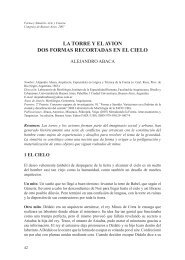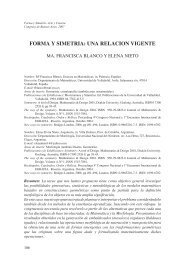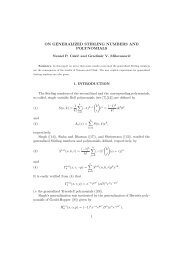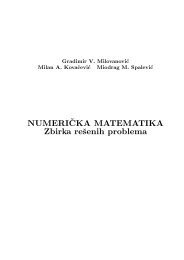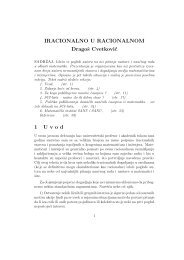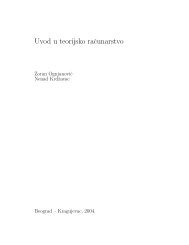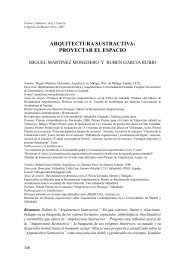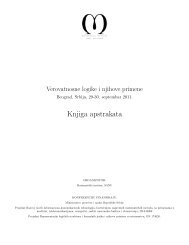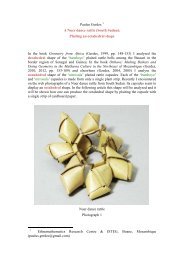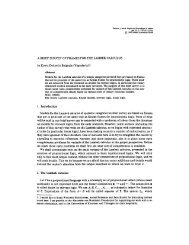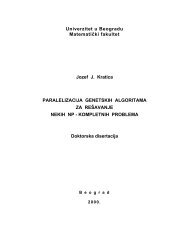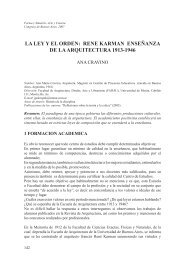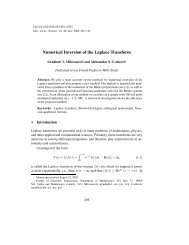The Birch and Swinnerton-Dyer Conjecture
The Birch and Swinnerton-Dyer Conjecture
The Birch and Swinnerton-Dyer Conjecture
You also want an ePaper? Increase the reach of your titles
YUMPU automatically turns print PDFs into web optimized ePapers that Google loves.
<strong>The</strong> <strong>Birch</strong> <strong>and</strong> <strong>Swinnerton</strong>-<strong>Dyer</strong> <strong>Conjecture</strong><br />
by<br />
A. Wiles<br />
A polynomial relation f(x, y) = 0 in two variables defines a curve C. If the coefficients<br />
of the polynomial are rational numbers then one can ask for solutions of the equation<br />
f(x, y) =0withx, y ∈ Q,in other words for rational points on the curve. If we consider<br />
a non-singular projective model C of the curve then over C it is classified by its genus.<br />
Mordell conjectured,<strong>and</strong> in 1983 Faltings proved,the following deep result<br />
<strong>The</strong>orem [F1]. If the genus of C is greater than or equal to two, then C(Q) is finite.<br />
As yet the proof is not effective so that one does not possess an algorithm for finding the<br />
rational points. (<strong>The</strong>re is an effective bound on the number of solutions but that does not<br />
help much with finding them.)<br />
<strong>The</strong> case of genus zero curves is much easier. A Hasse principle argument shows that<br />
in this case C(Q) is non-empty if <strong>and</strong> only if C has p-adic points for all primes p,<strong>and</strong><br />
this in turn is determined by a finite number of congruences. If C(Q) isnon-emptythen<br />
C is parametrized by rational functions <strong>and</strong> there are infinitely many rational points. For<br />
conics this goes back to Legendre.<br />
<strong>The</strong> most elusive case is that of genus 1. <strong>The</strong>re may or may not be rational solutions<br />
<strong>and</strong> no method is known for determining which is the case for any given curve. Moreover<br />
when there are rational solutions there may or may not be infinitely many. If C has a<br />
rational point then C is called an elliptic curve <strong>and</strong> the set of rational points has a natural<br />
structure as an abelian group as was observed by Poincaré [P]. In 1922 Mordell ([M]) proved<br />
that this group is finitely generated,thus fulfilling an implicit assumption of Poincaré.
<strong>The</strong>orem. If C is an elliptic curve over Q then<br />
C(Q) ≃ Z r ⊕ (finite group).<br />
In the case where C is of genus 1 <strong>and</strong> C(Q) ≠ ∅ we can find an affine model for the<br />
curve in Weierstrass form<br />
C: y 2 = x 3 + ax + b<br />
with a, b ∈ Z. We let ∆ denote the discriminant of the cubic <strong>and</strong> set<br />
N p := #{solutions of y 2 ≡ x 3 + ax + b mod p}<br />
a p := p − N p .<br />
then we can define the incomplete L-series of C (incomplete because we omit the Euler<br />
factors for primes p|2∆) by<br />
L(C, s) := ∏<br />
(1 − a p p −s + p 1−2s ) −1 .<br />
p∤2∆<br />
We view this as a function of the complex variable s <strong>and</strong> this Euler product is then known<br />
to converge for Re(s) > 3/2. A conjecture going back to Hasse (see the commentary<br />
on 1952(d) in [We1]) predicted that L(C, s) should have a holomorphic continuation as a<br />
function of s to the whole complex plane. This has now been proved ([W],[TW],[BCDT]).<br />
We can now state the problem:<br />
<strong>Conjecture</strong> (<strong>Birch</strong> <strong>and</strong> <strong>Swinnerton</strong>-<strong>Dyer</strong>). <strong>The</strong> Taylor expansion of L(C, s) at s =1has<br />
the form<br />
L(C, s) =c(s − 1) r + higher order terms<br />
with c ≠0<strong>and</strong> r =rank(C(Q)).<br />
In particular this conjecture asserts that L(C, 1) = 0 ⇔ C(Q) is infinite.<br />
2
Remarks. 1. <strong>The</strong>re is a refined version of this conjecture. In this version one has to define<br />
Euler factors at primes p|2∆ to obtain the completed L-series, L ∗ (C, s). <strong>The</strong> conjecture<br />
then predicts that L ∗ (C, s) ∼ c ∗ (s − 1) r with<br />
∏<br />
c ∗ = |X C |R ∞ w ∞ w p .<br />
Here |X C | is the order of the Tate-Shafarevich group of the elliptic curve C, agroup<br />
which is not known in general to be finite although it is conjectured to be so. It counts the<br />
number of equivalence classes of homogeneous spaces of C which have points in all local<br />
fields. <strong>The</strong> term R ∞ is a regulator,in other words a determinant whose matrix entries are<br />
given by a height pairing applied to a system of generators of C(Q)/C(Q) tors . <strong>The</strong> w p ’s<br />
are elementary local factors <strong>and</strong> w ∞ is a simple multiple of the real period of C. For a<br />
precise definition of these factors see [T1] or [T3]. It is hoped that a proof of the conjecture<br />
would also yield a proof of the finiteness of X C .<br />
2. <strong>The</strong> conjecture can also be stated over any number field as well as for abelian<br />
varieties,see [T1]. Since the original conjecture was stated much more elaborate conjectures<br />
concerning special values of L-functions have appeared,due to Tate,Deligne,Bloch,<br />
Beilinson <strong>and</strong> others,see [T2],[Bl] <strong>and</strong> [Be]. In particular these relate the ranks of groups<br />
of algebraic cycles to the order of vanishing (or the order of poles) of suitable L-functions.<br />
3. <strong>The</strong>re is an analogous conjecture for elliptic curves over function fields. It has been<br />
proved in this case by Artin <strong>and</strong> Tate [T1] that the L-series has a zero of order at least r,<br />
but the conjecture itself remains unproved. In the function field case it is now known to<br />
be equivalent to the finiteness of the Tate-Shafarevich group,[T1],[Mi] corollary 9.7.<br />
4. If proven the conjecture (at least in the stronger form) would give an effective<br />
means of finding generators for groups of rational points. This was shown by Manin [Ma]<br />
subject to the condition that the elliptic curves were modular,a property which is now<br />
known for all elliptic curves by [W],[TW],[BCDT]. (A modular elliptic curve is one which<br />
occurs as a factor of the Jacobian of a modular curve.)<br />
p|2∆<br />
3
Early History<br />
Problems on curves of genus 1 feature prominently in Diophantus’ Arithmetica. It is<br />
easy to see that a straight line meets an elliptic curve in three points (counting multiplicity)<br />
so that if two of the points are rational then so is the third. 1 In particular if a tangent<br />
is taken to a rational point then it meets the curve again in a rational point. Diophantus<br />
implicitly uses this method to obtain a second solution from a first. However he does<br />
not iterate this process <strong>and</strong> it is Fermat who first realizes that one can sometimes obtain<br />
infinitely many solutions in this way. Fermat also introduced a method of ‘descent’ which<br />
sometimes permits one to show that the number of solutions is finite.<br />
One problem considered in antiquity was the congruent number problem. One way of<br />
stating it is to ask which rational integers can occur as the areas of right-angled triangles<br />
with rational length sides. Such integers are called congruent numbers. For example,<br />
Fibonacci was challenged in the court of Frederic II with the problem for n =5<strong>and</strong>he<br />
succeeded in finding such a triangle. He claimed moreover that there was no such triangle<br />
for n = 1 but the proof was fallacious <strong>and</strong> the first correct proof was given by Fermat.<br />
<strong>The</strong> problem dates back at least to Arab manuscripts of the 10 th century (for the history<br />
see [We2] chapter 1, §VII <strong>and</strong> [Di] chapter XVI). This problem is closely related to the<br />
problem of determining the rational points on the curve C n : y 2 = x 3 − n 2 x. Indeed<br />
C n (Q) is infinite ⇐⇒ n is a congruent number<br />
Assuming the <strong>Birch</strong> <strong>and</strong> <strong>Swinnerton</strong>-<strong>Dyer</strong> conjecture (or even the weaker statement that<br />
C n (Q) is infinite ⇔ L(C n , 1) = 0) one can show that any n ≡ 5, 6, 7 mod 8 is a congruent<br />
number <strong>and</strong> moreover Tunnell has shown,again assuming the conjecture,that for n odd<br />
<strong>and</strong> square-free<br />
n is a congruent number ⇐⇒<br />
#{x,y, z ∈ Z: 2x 2 + y 2 +8z 2 = n}<br />
=2× #{x, y, z ∈ Z: 2x 2 + y 2 +32z 2 = n},<br />
with a similar criterion if n is even ([Tu]). Tunnell proved the implication right to left<br />
unconditionally with the help of the main theorem of [CW] described below.<br />
1 This was apparently first explicitly pointed out by Newton.<br />
4
Recent History<br />
It was the 1901 paper of Poincaré which started the modern theory of rational points<br />
on curves <strong>and</strong> which first raised questions about the minimal number of generators of C(Q).<br />
<strong>The</strong> conjecture itself was first stated in the form we have given in the early 1960’s (see [BS]).<br />
It was found experimentally using one of the early computers EDSAC at Cambridge. <strong>The</strong><br />
first general result proved was for elliptic curves with complex multiplication. <strong>The</strong> curves<br />
with complex multiplication fall into a finite number of families including {y 2 = x 3 − Dx}<br />
<strong>and</strong> {y 2 = x 3 − k} for varying D, k ≠ 0. This theorem was proved in 1976 <strong>and</strong> is due to<br />
Coates <strong>and</strong> Wiles [CW]. It states that if L(C, 1) ≠0thenC(Q) is finite. In 1983 Gross <strong>and</strong><br />
Zagier showed that if C is a modular elliptic curve <strong>and</strong> L(C, 1) = 0 but L ′ (C, 1) ≠0,then<br />
an old construction of Heegner actually gives a rational point of infinite order. Using new<br />
ideas together with this result,Kolyvagin showed in 1990 that for modular elliptic curves,<br />
if L(C, 1) ≠0thenr =0<strong>and</strong>ifL(C, 1) = 0 but L ′ (C, 1) ≠0thenr = 1. In the former<br />
case Kolyvagin needed an analytic hypothesis which was confirmed soon afterwards; see<br />
[Da] for the history of this <strong>and</strong> for further references. Finally as noted in remark 4 above it<br />
is now known that all elliptic curves over Q are modular so that we now have the following<br />
result:<br />
<strong>The</strong>orem. If L(C, s) ∼ c(s − 1) m with c ≠0<strong>and</strong> m =0or 1 then the conjecture holds.<br />
In the cases where m = 0 or 1 some more precise results on c ∗ (which of course depends<br />
on the curve) are known by work of Rubin <strong>and</strong> Kolyvagin.<br />
Rational Points on Higher Dimensional Varieties<br />
We began by discussing the diophantine properties of curves,<strong>and</strong> we have seen that<br />
the problem of giving a criterion for whether C(Q) is finite or not is only an issue for<br />
curves of genus 1. Moreover according to the conjecture above,in the case of genus 1,<br />
C(Q) is finite if <strong>and</strong> only if L(C, 1) ≠ 0. In higher dimensions if V is an algebraic variety,<br />
it is conjectured (see [L]) that if we remove from V (the closure of) all subvarieties which<br />
are images of P 1 or of abelian varieties then the remaining open variety W should have<br />
5
the property that W (Q) is finite. This has been proved in the case where V is itself a<br />
subvariety of an abelian variety by Faltings [F2].<br />
This suggests that to find infinitely many points on V one should look for rational<br />
curves or abelian varieties in V . In the latter case we can hope to use methods related to<br />
the <strong>Birch</strong> <strong>and</strong> <strong>Swinnerton</strong>-<strong>Dyer</strong> conjecture to find rational points on the abelian variety.<br />
As an example of this consider the conjecture of Euler from 1769 that x 4 + y 4 + z 4 = t 4<br />
has no non-trivial solutions. By finding a curve of genus 1 on the surface <strong>and</strong> a point of<br />
infinite order on this curve,Elkies [E] found the solution,<br />
2682440 4 + 15365639 4 + 18796760 4 = 20615673 4<br />
His argument shows that there are infinitely many solutions to Euler’s equation.<br />
In conclusion,although there has been some success in the last fifty years in limiting<br />
the number of rational points on varieties,there are still almost no methods for finding<br />
such points. It is to be hoped that a proof of the <strong>Birch</strong> <strong>and</strong> <strong>Swinnerton</strong>-<strong>Dyer</strong> conjecture<br />
will give some insight to this general problem.<br />
References<br />
[BCDT] Breuil,C.,Conrad,B.,Diamond,F.,Taylor,R.,On the modularity of elliptic<br />
curves over Q: wild3-adic exercises,preprint.<br />
[Be]<br />
Beilinson,A.,Notes on absolute Hodge cohomology,Applications of algebraic<br />
K-theory to algebraic geometry <strong>and</strong> number theory,Contemp. Math. 55 (1986),<br />
35–68.<br />
[Bl] Bloch,S.,Height pairings for algebraic cycles,J. Pure Appl. Algebra 34 (1984)<br />
119–145.<br />
[BS]<br />
[CW]<br />
<strong>Birch</strong>,B.,<strong>Swinnerton</strong>-<strong>Dyer</strong>,H.,Notes on elliptic curves II,Journ. reine u. angew<strong>and</strong>te<br />
Math. 218 (1965),79–108.<br />
Coates,J.,Wiles,A.,On the conjecture of <strong>Birch</strong> <strong>and</strong> <strong>Swinnerton</strong>-<strong>Dyer</strong>,Invent.<br />
Math. 39,223–251 (1977).<br />
6
[Da]<br />
[Di]<br />
[E]<br />
[F1]<br />
Darmon,H.,Wiles’ theorem <strong>and</strong> the arithmetic of elliptic curves,in Modular<br />
forms <strong>and</strong> Fermat’s Last <strong>The</strong>orem pp. 549–569,Springer (1997).<br />
Dickson,L.,History of the theory of numbers vol. II,<br />
Elkies,N.,On A 4 + B 4 + C 4 = D 4 ,Math. Comput. 51,No. 184 (1988) pp.<br />
825–835.<br />
Faltings,G.,Endlichkeitsätze für abelsche Varietäten über Zahlkörpern,Invent.<br />
Math. 73,No. 3 (1983) pp. 549–576.<br />
[F2] Faltings,G.,<strong>The</strong> general case of S. Lang’s conjecture,Perspec. Math.,vol. 15,<br />
Academic Press,Boston (1994).<br />
[GZ]<br />
[K]<br />
Gross,B.,Zagier,D.,Heegner Points <strong>and</strong> Derivatives of L-series,Invent. Math.<br />
84 (1986) pp. 225–320.<br />
Kolyvagin,V.,Finiteness of E(Q) <strong>and</strong> X(E,Q) for a class of Weil curves,Math.<br />
USSR,Izv. 32 (1989) pp. 523–541.<br />
[L] Lang,S.,Number <strong>The</strong>ory III,Encyclopædia of Mathematical Sciences,vol. 60,<br />
Springer-Verlag,Heidelberg (1991).<br />
[M]<br />
[Ma]<br />
Mordell, On the rational solutions of the indeterminate equations of the third <strong>and</strong><br />
fourth degrees,Proc. Cambridge Phil. Soc. 21 (1922-23),179–192.<br />
Manin,Y.,Cyclotomic Fields <strong>and</strong> Modular Curves,Russian Mathematical Surveys<br />
vol. 26,no. 6,pp. 7–78. (1971).<br />
[Mi] Milne,J.,Arithmetic Duality <strong>The</strong>orems,Academic Press,Inc. (1986).<br />
[P]<br />
[T1]<br />
[T2]<br />
Poincaré,H.,Sur les Propriétés Arithmétiques des Courbes Algébriques,Jour.<br />
Math. Pures Appl. 7,Ser. 5 (1901).<br />
Tate,J.,On the conjectures of <strong>Birch</strong> <strong>and</strong> <strong>Swinnerton</strong>-<strong>Dyer</strong> <strong>and</strong> a geometric analog,Seminaire<br />
Bourbaki 1965/66,no. 306.<br />
Tate,J.,Algebraic Cycles <strong>and</strong> Poles of Zeta Functions,in Arithmetical Algebraic<br />
Geometry,Proceedings of a conference at Purdue University (1965).<br />
[T3] Tate,J.,<strong>The</strong> Arithmetic of Elliptic Curves,Inv. Math. 23,pp. 179–206 (1974).<br />
[Tu] Tunnell,J.,A classical diophantine problem <strong>and</strong> modular forms of weight 3/2,<br />
Invent. Math. 72 (1983) pp. 323–334.<br />
[TW]<br />
Taylor,R.,Wiles,A.,Ring-theoretic properties of certain Hecke algebras,Ann.<br />
of Math. vol. 141,no 3 (1995) 553–572.<br />
[W] Wiles,A.,Modular Elliptic Curves <strong>and</strong> Fermat’s Last <strong>The</strong>orem,Ann. Math. 142<br />
(1995) pp. 443–551.<br />
[We1]<br />
Weil,A.,Collected Papers,Vol. II.<br />
[We2] Weil,A.,Basic Number <strong>The</strong>ory,Birkhaüser,Boston (1984).<br />
7



